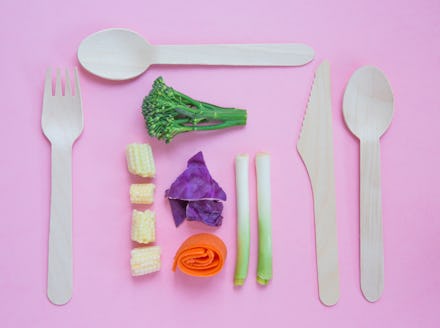What to do with single-use plastic you already have

I was topping my pizza with Follow Your Heart Vegan Mozzarella Shreds when I noticed something unique about the packaging. It stated “From the solar panels that cover our roofs to these new and smaller bags that use 14% less plastic, we are dedicated to finding new ways to improve our efficiencies and reduce our waste.”
Of the 300 million tons of plastic generated each year, approximately 10 to 20 tons end up in oceans, according to research from Drake University. A 14 percent reduction in plastic packaging is a small yet important step in managing this environmental crisis.
“We’re a Zero Waste certified company, so we are very aware of the materials we use, their lifecycle, and how we can continue to reduce the environmental impact of our processes and products,” said Sheena DeBellis, director of quality and sustainability at Follow Your Heart’s Earth Island.
Follow Your Heart is among a long list of companies consciously aiming to reduce their carbon footprint through campaigns to minimize their single-use plastic output. Earlier this year, Starbucks pledged to phase out plastic straws by 2020, and by 2025, 100 percent of Evian water bottles will comprise of recycled plastic. Numerous companies have vowed to follow suit.
While we should certainly aim to follow their lead in reducing our plastic use, it can be a difficult choice to make when we already own so much of it, from an economy-sized box of straws we bought years ago, to grocery bags we accumulate under the sink to every type of plastic cutlery for all those “just in case” picnics.
Follow Your Heart’s mission to reduce plastic is a work in progress, and they encourage yours to continuously evolve, too. “By calling attention to the reduction in plastic on the package, we hope to remind our customers about the importance of plastic reduction,” said DeBellis.
Why there’s no one-size-fits-all solution to how we should manage the single-use plastic we already have, here are some strategies to think about.
Adjust your mindset
When it comes to single-use plastic, your first step is refraining from accumulating even more. Annie McBride, a copywriter at sustainable clothing company Outerknown, said to start by declining plastic cups, straws, utensils and bags when shopping or attending events.
“Just be conscious of what you buy and what you accept. Whatever is in your hands, envision where it’s going after you’re done with it. If its fate is the landfill, then figure out how to cut that out in the future,” she said.
If you’re unsure of where your materials will end up, visit your local waste sorting facilities or call your local sanitation or waste management office to learn more.
Recycle straws carefully
In an ideal world, DeBellis said, we may use the single-use plastic we already have as long as we recycle it properly – but straws are a challenge. Often, recycling equipment is not able to process them due to their size and shape. She suggested placing the straws inside larger plastic containers so they stand a better chance of being recycled.
“The key is to make sure the larger plastic container is made of the same plastic as the straw (type 5, polypropylene). Type 5 plastics are marked with a 5 inside the recycling symbol. Examples of type 5 plastics are microwave-safe containers, yogurt containers, medicine bottles and margarine containers,” she said. Not all curbside recycling accepts polypropylene, but you can check earth911.com for more information.
“There’s a lot of excitement around straws these days,” said Reece Pacheco, executive director of WSL PURE, the World Surf League’s ocean conservation nonprofit. He pointed out that your options include metal straws, seaweed straws, and straw straws — but if you don’t require one, you can always just use your lips.
Donate cutlery
If you have cutlery lying around, Pacheco suggested donating them to a local community shelter or food pantry in order to reduce their demand. “I always go back to the 3 R’s. Reduce, reuse, recycle, and it’s reduce that means the most,” said Pacheco. The goal is for those donated plastic cutlery items to then be recycled (there’s no harm in requesting your recipient does so).
Ask for no plastic cutlery at a restaurant, and use your own multi-use utensil (bamboo sporks, anyone?). Better yet, he said, order a meal that doesn’t require the use of cutlery, like a sandwich or pizza.
Reuse bags...or find them a new home
According to McBride, there’s no reason to throw out or recycle single-use plastic like grocery bags or Ziploc bags you haven’t even used.
“I posted them for free on the Nextdoor community chat and a lady nearby could use them. That’s at least a few less plastic bags that she’ll buy new,” she said, adding that Craigslist or Facebook community groups are also great resources. Once you’ve cleared out the endless pile of grocery bags from under the sink, aim to use reusable snack bags while traveling and at work.